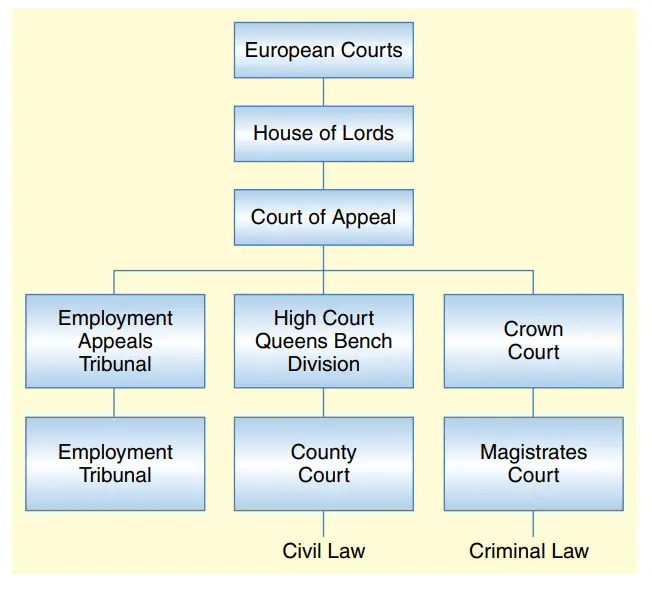The intricacies of the legal framework governing health and safety in the United Kingdom are at the core of every working environment. This framework, with its array of laws, guidelines, and precedents, serves as the essential bedrock for a safe and healthy workplace nationwide.
In this comprehensive blog, we will delve deep into the realms of this vast legal ecosystem, exploring everything from criminal and civil courts, common torts, and duties in common law to the pivotal role of the European Union in shaping health and safety standards. We aim to demystify this complex legal matrix and help you understand how it informs daily workplace operations, impacts rights and responsibilities, and shapes the contours of health and safety best practices in the UK.
Various health and safety laws are in place to protect employees in the workplace. In this blog post, we will discuss the most important ones. Employers should be familiar with these laws and ensure that their work complies.
Sub-divisions of law
Two sub-divisions apply to health and safety issues: criminal and civil law.
1. Criminal law
Criminal law is the rules of conduct laid by the Government or the State. They are typical; the Parliament enacts them in Acts that Parliament passes. These laws, also known as Acts, are imposed on citizens to safeguard the population. Different government agencies enforce the law, which can prosecute organizations and individuals for breaking criminal laws. It is crucial to remember that, except in limited circumstances, only these agencies can decide whether to pursue a person.
Any person or company that violates the law of criminals is considered to have committed an offense. If you are charged and found guilty, the Court will decide whether it is true. The Court may sentence the accused to jail or a fine if the accused is found guilty. In light of this possibility of restriction of freedom, the standard of evidence that the Criminal Court requires is very high and is referred to as proof beyond a reasonable doubt, which is as close to certainty as possible.
The primary purpose of the Criminal Court is the allocation of punishment. The Court may give compensation to the injured or victim or injured party. One instance of criminal law includes one of these laws is the Road Traffic Act, which is enforced by the police. The Act is a different example of criminal law. This is enforced through HSE or local authorities. HSE, as well as Local Authority Environmental Health Officers (EHOs). The Fire Authority, the Environment Agency, Trading Standards, and Customs and Excise are other organizations that enforce criminal laws.
There is a significant difference between criminal cases generally and those involving safety and health. Criminal cases must demonstrate whether the defendant is beyond a reasonable doubt. While this requirement isn’t eliminated in matters involving health and safety and subsection 40 under the HSW Act, 1974 transferred, when there is a requirement to perform a task as practicable or as in the extent that is practical or employs the possible method, and the burden of proof is on the defendant to prove the evidence that they had no alternative method to fulfill their obligation according to the Act. But, when the burden of proof falls upon the defendant, the latter has to prove to the Court that they have the probability of completing what they’re trying to prove.
2. Civil law
Civil law is about disputes between individuals or between corporations and individuals. A person sues another or company to resolve a tort or civil wrong (or negligence or delict in Scotland). The person who submits their complaint before Court is called the claimant or the plaintiff (pursuer or pursuer in Scotland). The company or person being sued is called the defendant (defender in Scotland).
A Civil Court is concerned with the degree of that liability rather than guilt or guilt. Thus, the evidence required is based on a “balance of probability,” a lower degree of certainty than “beyond a reasonable doubt,” which is the Criminal Court’s standard. If the defendant is found to be liable to be found liable, the Court will generally require the defendant to pay compensation and expenses to the victim. The less likely the balance of probabilities and the lower the amount of the granted payment. In extreme circumstances, where the balance of probabilities is 50 percent, the plaintiff could win the case but suffer financially because costs might not be awarded.
The amount of compensation may be very low. The payment amount can be reduced due to the defense of the contributory negligence defense, which will be further discussed under Section 1.8. Civil disputes typically arise from injuries or accidents and involve the negligence of others or breach of the statutory obligation in cases involving people’s safety and health. The majority of cases are settled out of court’. However, most cases involve two individuals; if they are between employees performing the duties of his/her job at the time of the incident, the defense of the incident is transferred to the employer. This is known as vicarious responsibility. The civil lawsuit will then become one between the person and the company.
The Employers ‘ Liability (Compulsory Insurance) Act makes it a legally binding obligation for all employers to be covered by insurance for their liability. This guarantees that any employee who can sue his employer in the aftermath of an injury can be certain that they will be compensated regardless of the business’s financial standing.
The maximum fine can reach PS 2500 per day if there is no adequate insurance coverage for employers that do not have this insurance. Additionally, at least one copy of the certificate in force must be displayed at every place of business and reasonably secured from damage. Recently, the regulations requiring employers to present the certificate have been changed. The requirement can be met when the certificate is issued electronically and easily accessible to employees.
The legal system of England as well as Wales
The following information applies to the following description of England and Wales (with some minor variations in Northern Ireland). The only court-related functions relating to safety and health are addressed. Figure 1.2 illustrates the Court’s structure in a schematic format.

1. Criminal law
Magistrates Courts
The majority of criminal cases start and conclude in Magistrates Courts. Police officers present the Court cases involving health and safety (Health and Safety Executive or Local Authority Environmental Health Officials). They are argued before a bench consisting of three magistrates who are lay (known as Justices of the Peace) or one district judge. Lay magistrates are public members, typically with no prior experience in law, and District judges are legally certified.
A Magistrates Court has limited powers with a maximum penalty of PS 5000 for employees and PS 20000 for employers and people disregarding warnings about prohibitions. Magistrates also have the power to be imprisoned for up to 6 months. Magistrates Court handles most health and safety-related criminal cases. Magistrates Court. Check Table 17.1 for the new penalties in the Health and Safety Offences Act 2008.
Crown Court
The Crown Court generally hears the more severe cases handed over to them by the Magistrates Court because the sentences available to magistrates are considered excessively lenient. A jury and judge decide the cases; however, some cases are referred to one judge. The sanctions that are available to Crown Court judges Crown Court are an unlimited fee and up to two years ‘ imprisonment for violations in enforcement notifications. It is also the place to appeal any enforcement notices. Crown Court also hears appeals from the Magistrates Court. Appeal proceedings an appeal to the Crown Court are made to the Court of Appeal (Criminal Division), which can then grant permission to appeal to the most high-ranking Court that is in existence, The House of Lords. The highest-ranking judge on the Court of Appeal is the Lord Chief Justice.
2. Civil law
County Court
The most miniature Civil Court is the County Court, which can only handle more minor instances (for compensation claims upwards of PS 50 000 if the High Court agrees it agrees). Most cases are dealt with by a judge sitting on his own. If personal injury claims are less than PS 5000, the small claims court can be accessible.
High Court
Many health and safety civil cases are heard by the High Court (Queens Bench Division) in the presence of a judge. It handles claims for compensation that exceed PS 50 000. It also acts as an appeals judge for County Court. Appeal proceedings made by the High Court are made to the Court of Appeal (Civil Division). The House of Lords receives appeals from the Court of Appeal or direct from the High Court regarding matters of interpretation of the law. The highest-ranking judge in the Court of Appeal is the Master of the Rolls. The judges of the House of Lords are called Law Lords and are often asked to give judgments regarding legal matters that become legally binding for lower courts. These judgments are the foundation for common law that will be further discussed later.
Other tribunals Employment Tribunals Employment Tribunals
They were created in 1964 and primarily focused on employment and conditions of service, like unfair dismissal. They also hear appeals involving health and safety violations, disputes between safety representatives recognized by the law and their employers, and instances of unfair dismissal involving health and safety concerns. Three members are typically the ones of the tribunal. The members are appointed by the tribunal and often do not certified. The tribunal’s appeals can be taken by the Employment Appeal Tribunal or, in the event of enforcement notices in the case of enforcement notices, to the High Court. Tribunal appeals are only able to address the clarification of legal points.

Common Torts and Duties in the common law
1. Negligence
Negligence is the only crime (civil wrong) that has real significance in health or safety concerns. Negligence refers to the failure to exercise reasonable care or behavior that can cause other injuries, damages (or financial loss). Whether you believe the Act or omission caused the injury or damage is typically decided in the context of a court case or a settlement out of Court. There have been two significant judgments that have challenged the legal definition of negligence. In 1856, the Court ruled that negligence had to refer to omissions or acts and the need for responsible and prudent conduct. In 1932 Lord Atkin declared:
It would be best to exercise the necessary care not to commit acts or omissions you can reasonably predict are likely to harm your neighbor. What, then, is my neighbor? The answer is those who are so directly affected by the Act that I am entitled to think of them because they’re so impacted while I focus on my thoughts on the Acts or omissions being questioned.
It can be concluded that, for negligence to be proven, it must be reasonable and probable that the injury can result from an act or omission. In reality, the Court might have to decide whether the person who suffers injury is a neighbor of the culprit. A collapsed scaffold can easily cause injury to a public member who might be a neighbor of the scaffold constructor. A person who is suing their employer for negligence must determine the following three requirements:
- A duty was due to the worker by his employer since the incident occurred in the course of work;
- This duty was violated because the incident was visible, and all reasonable precautions hadn’t been taken.
- The breach led to a specific injury, illness damage, or loss.
These tests must be utilized by any person impacted by the employer’s undertaking (such as contractors and public members) who seeks to sue the employer for incompetence.
Two additional defenses can be used if the employer cannot argue against the three elements. One could argue the worker was aware of the dangers they took in not following safety guidelines (known by the Latin term volenti or non-fit injury, or “the risk was voluntarily accepted ). This defense will likely succeed because courts have found that employees did not voluntarily accept the risk. After all, economic pressures force employees to work. Another defense is ‘contributory negligence ‘ in which the employee is found to contribute to the negligent Act. If this defense is successful, it will significantly lower the amount of compensation (by at least 80% in certain instances). Any negligence claim must be filed within a specific timeframe (currently three years).
2. Duty Of Care
Several judgments have established that employers have a duty of care to all employees. This obligation is not transferable to other employees, regardless of whether consultants are employed to assist with health and safety issues or if employees are subcontracted to another company. The duty can be divided into several groups. Employers must:
- Ensure a safe and secure space for work, with access to and exits;
- Provide safe equipment and plants;
- Provide a secure system for work
- Ensure that your fellow employees are safe and knowledgeable; employees;
- Provide adequate supervision, information, and instruction.
Common law employer duties are often replicated within statute law. Essentially, this is because they are both common law and statutory obligations. This applies regardless of whether the employee is on premises owned by a third party or hired by an employer to join a different employer. The rules for a safe workplace, such as the upkeep of floors and flooring and the installation of safe walkways and stairways, are also covered in the Workplace (Health Safety and Well-being) Regulations. The requirement for competent coworkers is part of a sufficient level of instruction and training. In the past, employers were responsible for the conduct of their staff ( vicarious responsibility ) as long as the activity was carried out in the course of their job.

The Impact of the European Union on Health and Safety
Since Britain is a member of the European Union, much of the law governing health and safety originates from Europe. The member states may agree on the proposals of the European Commission. The member states are accountable for making them the law of their country. In Britain and across much of Europe, health and safety laws are built on the concept of risk assessment, as described in Chapter 5. The EU’s principal function in health and safety concerns is to ensure the uniformity of legal and workplace standards and remove obstacles to trade between member states.
A directive from the EU is legally binding for every member state and has to be included in the law of the nation of every member state. Commands define specific goals that must be incorporated into the nation’s laws. Some states implement Directives earlier than other states. Directives are put forward through the European Commission, comprising commissioners who are residents of all state members. The proposed Directives are sent directly to the European Parliament, which the EU members now elect.
The European Parliament can accept, modify or even reject the proposed directives. The Directives proposed are sent through the Council of Ministers, which could accept the proposed directives by an affirmative majority vote or, except if the European Parlament rejects them, vote against the directives, in which case a majority decision only approves them of the Council. The Council of Ministers consists of one senior minister from each member.
The power of the EU in terms of health and safety law stems from the Treaty of Rome 1957 and the Single European Act 1986. To protect health and safety, health and safety, the Single European Act added two additional Articles: 100A and 118A. It was 1997 when the Treaty of Amsterdam renumbered them as 95A and 138A, respectively. Article 95A concerns standards for health and safety in plants and equipment, and its Directives are enforced throughout the UK by the Department for Business Enterprise and Regulatory Reform.
Article 138A is concerned with minimum health and safety standards in employment, and its Directives are implemented by the Health and Safety Commission/Executive. The Single European Act 1986 aims to establish a “level playing field” for every member state to ensure that services and goods can be freely circulated throughout the EU without one country being unfairly advantaged over the other. Harmonizing safety and health requirements throughout the EU is a prime illustration of the ‘level playing field. ‘
The first adoption of an EU Directive into UK health and safety laws occurred in January 1993 when the Framework Directive on Health and Safety Management and four daughter Directives were introduced under the power included within the HSW Act 1974. These Directives, also known by the name of European Six Pack, covered the following areas:
- Management of the safety and health of workers;
- Workplace;
- Usage and the provision of work equipment
- Manual handling;
- Personal protective equipment;
- Display screen equipment
In conclusion, understanding the legal framework for health and safety in the UK is imperative for all stakeholders, from employers to employees and everyone in between. This framework, comprising different court systems, common torts, and European Union directives, is designed to safeguard the rights and well-being of all workers. By adhering to established laws, regulations, and standards, businesses can ensure a safer and healthier work environment and foster a culture of responsibility and compliance. This informed, collaborative commitment to health and safety, underscored by a robust legal infrastructure, paves the way for productive, harmonious, and resilient workplaces in the face of evolving challenges.

